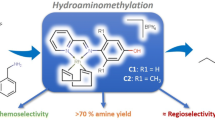Abstract
Seven chiral thiazolidines bound rhodium complexes were synthesized and their catalytic asymmetric hydrosilation properties were investigated. It was found through investigation that the configuration of newly formed chiral centre C *2 of substituted chiral thiazolidines prepared from L-cysteine or its esters has no effect on the final results of catalytic asymmetric hydrosilation. The direct reason for causing this phenomenon is reported by the present quantitative results for the first time: the rapid racemation of chiral center C *2 of chiral thiazolidine ligands takes place under the catalysis of rhodium(I) complex [Rh(COD)Cl]2.
Similar content being viewed by others
References
Bergen, S. H., Nohecia, P, Whelan, J.et. al., Asymnietrlc catalysis: Production of chiral diols by enantioselective catalytic intramolecular hydrosilatiorl of olefins,J. An1. Chem. Soc., 1992, 114: 2121.
Uozumi, Y., Hayashi, T., Catalytic asymmetric synthesis of optically active 2-alkanols via hydrosilation of 1-alkenes with a chiral monophosphine-palladium catalyst,J. Am. Chenz. Soc., 1991, 113: 9887.
Uozumi, Y., Hayashi, T., Asymmetric hydrosilation of dihydrofurans by use of palladium-MOP catalyst,Tetrahedron Lett., 1993, 34: 2335.
Halterman, R. L., Synthesis and applications of chiral cyclopentadienyl metal complexes,Chem. Rev., 1992, 92: 965.
Nishigama, H., Yamaguchi, S., Konclo, M.et al., Electronic substituent effect of nitrogen ligands in catalytic asymmetric hydrosilation of ketones: chiral 4-substituted bis(oxazolinyl) pyridines,J. Org. Chem., 1992, 57: 4306.
Balavoine, G., Clinet, J. C., Lellouchi, I., Enantloselective hydrosilation of acetophenone with rhodium/oxazolines catalysts,Tetrahedron Lett., 1989, 30: 5141.
Botteghi, C., Schionato, A., Chelucci, G,et al., Asymmetrische katalysen (XLVI): Enantioselektive hydrosilylierung von ketonen mit [Rh(COD)Cl]2 und optisch aktiven Stickstoff-Liganden,J. Organomet. Chetn., 1989, 370: 17.
Chatt,J., Venanz,L.M., Olefin coordination compounds, Part VI: Diene complexes of rhodium (I),J. Chem. Soc., 1957, (12): 4735.
Benkeser, R. A., Landesman, H., Foster, D. J., The formation of arylsilylpotassium compounds,J. Am. Chem. Soc., 1952, 74: 648.
Nagasawa, H. T., Goon, D. J. W., Sherota, F. N., Epimerization at C-2 of 2-substituted thiazolidine-4-carboxylic acids,J. Heterocycl. Chem., 1981, 18: 1047.
Szilagyi, L., Gyorgydeak, Z., Comments on putative stereoselectivity in cysteine-aldehyde reactions: Selective C(2) inversion and C(4) epimerization in thiazolidine-4-carboxylic acids,J. Am. Chem. Soc., 1979, 101: 427.
Pesek, J. J., Frost, J. H., Decomposition of thiazolidines in acidic and basic solutions,Tetrahedron, 1975, 31: 907.
Author information
Authors and Affiliations
Additional information
Project supported by the Natural Science Foundation of Tianjin Science and Technology Commission.
Rights and permissions
About this article
Cite this article
Li, H., Yao, J. & He, B. Application of chiral thiazolidine ligands to asymmetric hydrosilation. Sc. China Ser. B-Chem. 40, 485–490 (1997). https://doi.org/10.1007/BF02875416
Received:
Issue Date:
DOI: https://doi.org/10.1007/BF02875416




